The road and carriageway are different. The road and its components.
Like any field of knowledge or academic discipline, Rules traffic have a whole system of concepts (or terms). Imagine how difficult it would be to learn material, for example, in mathematics, if such concepts as integral, rational numbers, function, etc.
So traffic rules use in their vocabulary its own - purely traffic rules-shnuyu - terminology. And the lion's share of section 1 of the Rules (the entire paragraph 1.2) is devoted exclusively to the concepts used in the traffic rules.
Before proceeding to a direct analysis of these concepts, let us make one important remark. A cursory glance at the text of paragraph 1.2, one can conclude that the convenient way systematization of the material. All terms are in alphabetical order.
And it turns out the following: for example, two similar concepts - "stop" and "parking" - should be considered in parallel. In reality, they turn out to be “divorced” thanks to the alphabetical system of systematization. And the integrity of the perception of information about them is violated, and continuity is lost.
That is why we will analyze not each concept separately, but blocks of concepts united by some related features.
So, in the last article, we examined the basic principles of traffic rules. Starting with this article, we begin to study the basic concepts used in traffic rules.
It seems to us that the concept of the road is central in the Rules of the Road. Indeed, the Rules of the Road ...
"Road" - equipped or adapted and used for movement Vehicle a strip of land or the surface of an artificial structure. The road includes one or more carriageways, as well as tram tracks, sidewalks, shoulders and dividing lanes, if any.
Consider first the first part of this definition. So, “road” is a strip of land or a surface of an artificial structure that is equipped or adapted and used for the movement of vehicles ...
What does it mean? Very simple. The part of the earth's surface, which has the necessary infrastructure for the organization of traffic on it, is called a road.
For example, in front of you is a city road (more precisely, a road in a village).
And here, please, a country road (or a road outside locality).
However, the road can also be represented by an artificially created surface - a kind of structure (bridge, flyover, overpass). This is also a road.
Do not forget that the road can be temporary, intended for movement during the season or even for a shorter time. For example, a narrow strip laid by a bulldozer or grader in the middle of a snowy field.
It will be expensive only until the spring thaw or the beginning of the next cycle of agricultural work. But in this moment she is a road.
But the second part of the concept of "road" cannot be considered and understood without the involvement of other terms. Judge for yourself. The road includes one or more carriageways, as well as tram tracks, sidewalks, shoulders and dividing lanes, if any.
In other words, for the completeness of the disclosure of the concept of "road" we must analyze a number of terms. And, judging by the second part of the definition, the road has its own structural elements and consists of:
- The carriageway (or several carriageways);
- Dividing strip (or several dividing strips) - if any;
- Roadsides - if available;
- Sidewalks - if available;
- Tram lines - subject to availability.
Having considered these concepts, we can draw an adequate conclusion about what a road is.
Consider the ROADWAY.
"Carriageway" - an element of the road intended for the movement of trackless vehicles.
And here, let's talk about the confusion that often happens among novice or ignorant drivers. They believe that the road is (roughly speaking) that section of asphalt pavement on which cars move. Such a position is fundamentally wrong, erroneous.
The asphalt pavement section is precisely the CARRIAGE, that is, only the PART of the ROAD, which is intended for the movement of trackless vehicles (everything except trams) along it.
Let's make an intermediate conclusion. DRIVING ROAD - this is a mandatory, necessary element road, which is used exclusively for the movement of road transport. Formally (or legally), if there is no roadway, then there is no road itself. Agree, it is quite logical.
Let's continue. The next element of the road is the DIVIDING STRIP.
"Dividing strip" - an element of the road, allocated constructively and (or) using markings 1.2.1, separating adjacent carriageways and not intended for the movement and stopping of vehicles. And again, in order to better understand this concept Let's look at it in detail.
Firstly, "median strip" - an element of the road, ... separating adjacent carriageways.
The main function of the dividing strip is to delimit traffic flows (mainly opposite directions). This is done, for example, to ensure the greatest possible road safety.
After all, the dividing strip makes it minimal to enter the lanes intended for oncoming traffic. That is why the median strip is an indispensable element of the fastest road in Russian Federation- highways.
And here is the most important thing with regard to the dividing lines. By the fact of their presence, they distinguish two or more carriageways on the road.
For example, two carriageways, if there is only one dividing strip.
Or three carriageways, if there are two dividing lanes, etc.
The most representative type of dividing strip is the lawn shown in the figure above, bounded by curbs. This is, so to speak, a textbook example.
This is a constructive version of the dividing strip, that is, designed with the help of a physical structure - a lawn. This type may also include reinforced concrete, metal fences and other physical structures.
But the dividing strip can also be framed logically - with the help of a horizontal one, indicating the edge of the carriageway. This is exactly the same dividing line.
In this regard, it is necessary to add a comment. Quite often, drivers confuse the dividing strip marked with markings and the double solid marking line (horizontal). Let's try to close this topic once and for all.
You noticed that in the bottom figure, the distance between the white solid lines is equal to the width of any of the lines.
Remember! This is a double solid markup. And in the upper figure, the distance between the white lines exceeds the above value. So, this is the dividing line.
And, finally, one more characteristic of the dividing strip. "Dividing strip" - an element of the road, ... not intended for the movement and stopping of vehicles.
Here, as they say, without options. The dividing strip is not intended for vehicles, but solely for the allocation of adjacent carriageways. That is why it is impossible to move on it or make a stop and parking.
Let's sum up one more preliminary result.
The dividing strip is also an element of the road that separates a single carriageway across multiple lanes. It is important to remember that the dividing strip is not intended for movement, stopping and parking of vehicles. Its purpose is different. And it is not at all difficult to guess that the dividing strip is an optional element of the road.
"Side" - an element of the road adjacent directly to the carriageway at the same level with it, differing in the type of coverage or marked out using markings 1.2.1 or 1.2.2, used for driving, stopping and parking in accordance with the Rules.
The curb is also an element of the road. Ask why? It's just that in the vast majority of cases, the roadside is used to stop and park vehicles (and in exceptional cases, to move).
In turn, stopping and parking are modes of using vehicles, which are regulated by section 12 of the SDA. Therefore, the shoulder - purely logically - must also be an element of the road, bordering on carriageway., on reverse side which the curb begins.
Let's draw a conclusion and on the sidelines. The shoulder is another possible element of the road, which is directly adjacent to the carriageway and serves mainly to stop and park vehicles.
But this is not the end of the road. Another element of it is the sidewalk.
"Pavement" - an element of the road intended for the movement of pedestrians and adjacent to the carriageway or cycle path or separated from them by a lawn.
Here, in principle, everything is clear. However, the traditional question pops up: “Why is the sidewalk part of the road?”. Agree, at first glance, quite a reasonable remark. But this is only at first glance". Let me take a look at the arguments.
First, sidewalks are for pedestrians. And they are road users. It is quite logical that sidewalks are an element of the road.
Secondly, in some cases, vehicles are still allowed to move and park on sidewalks. And although these are very rare moments, but the fact, as they say, is obvious.
It should also be said that the sidewalk is an optional element of the road. For example, outside the locality, it is simply absent. For uselessness. Pedestrians move along the side of the road.
Summarize. Sidewalks are also part of the road that adjoins directly to the carriageway or is separated from it by a lawn.
The last element of the road is TRAMS, which are also not necessary and obligatory parts of the road. By the way, there is a tendency to eliminate trams as a form of public transport. It is both uneconomical and non-ergonomic.
By the way, traffic rules do not qualify tram tracks in any way, noting only that they are part of the road, but do not belong to the carriageway. The driver should be aware of this.
This could be the end of the first block of concepts related to the road. However, it would be appropriate to include here another term - TRAFFIC LANE.
The fact is that the movement of vehicles is carried out on the roadway (we already know this). The carriageway must be divided into traffic lanes.
"Lane" - any of the longitudinal lanes of the carriageway, marked or not marked with markings and having a width sufficient for the movement of cars in one row.
In other words, a traffic lane is an element of the roadway intended for the movement of one vehicle.
However, there are times when the markings on the roadway have not yet been applied, or when they have worn out and become indistinguishable, or when they are simply covered with snow, sand, a layer of dust or dirt. And, unfortunately, there are no signs.
It turns out that there are no traffic lanes on this roadway?
This is not true. Let's remember the definition: "traffic lane" - any of the longitudinal lanes of the carriageway, marked or not marked with markings ...
And if the traffic lanes on the carriageway are not marked in any way, then, in accordance with the requirements of Section 9 of the Rules, the driver is obliged to independently determine his position on the carriageway, taking into account:
- The width of the carriageway;
- vehicle dimensions;
- required spacing between them.
In other words, the driver is obliged to determine the number of lanes on the roadway "by eye". Sounds like a paradox? Not at all. This is a traffic law requirement. (By the way, we will dwell on this technique in more detail when analyzing Section 9 of the SDA).
Now let's take a concrete example.
How many lanes are on this roadway? Or let's ask the question in a different way: how many vehicles will pass safely in the cross section of the road? That's right, four. Before us is a four-lane road with two-way traffic(two lanes in each direction).
Thus, traffic lanes on the carriageway can be marked either visually (using markings or signs) or virtually (by the driver himself, taking into account the characteristics of the carriageway and the dimensions of vehicles).
So, we have examined in sufficient detail the concept of the road and its elements. Let's make a general conclusion.
A road is a part of the earth's land or an artificially created surface (bridge, overpass, overpass, crossing, etc.), which is provided for the movement of vehicles.
The road to includes the carriageway (or carriageways - depending on the presence of a median) divided into traffic lanes, as well as the median lane (or lanes), shoulders, sidewalks and tram tracks, if any.
Road train - a mechanical vehicle coupled to a trailer (trailers).
A bicycle is a vehicle, other than a wheelchair, which has at least two wheels and is generally propelled by the muscular energy of the occupants of the vehicle, in particular by means of pedals or handles, and may also have an electric motor of rated maximum power in mode continuous load not exceeding 0.25 kW, automatically shutting off at speeds over 25 km/h.
A cyclist is a person who rides a bicycle.
- a road element (or a separate road) structurally separated from the carriageway and sidewalk, intended for the movement of cyclists and marked with the sign 4.4.1
Driver - a person driving a vehicle, a driver leading pack, riding animals or a herd along the road. A driving instructor is equivalent to a driver.
Forced stop - the cessation of the movement of the vehicle due to its technical failure or danger posed by the cargo being transported, the condition of the driver (passenger) or the appearance of an obstacle on the road.
Hybrid vehicle - a vehicle that has at least 2 different energy converters (engines) and 2 different (on-board) energy storage systems for the purpose of propulsion of the vehicle.
- signposted road
| 2.1 | 2.3.1 | 2.3.2 | 2.3.3 | 2.3.4 | 2.3.5 | 2.3.6 | 2.3.7 | 5.1 |
in relation to the intersected (adjacent), or a paved road (asphalt and cement concrete, stone materials, etc.) in relation to an unpaved road, or any road in relation to exits from adjacent territories. The presence of a paved section on a secondary road immediately before the intersection does not make it equal in value to the crossed one.
Daytime running lights - external lighting devices designed to improve the visibility of a moving vehicle front in daylight hours days.
Road - a strip of land or a surface of an artificial structure, equipped or adapted and used for the movement of vehicles. The road includes one or more carriageways, as well as tram tracks, sidewalks, shoulders and dividing lanes, if any.
Road traffic - aggregate public relations arising in the process of moving people and goods with or without vehicles within the road.
A traffic accident is an event that occurred during the movement of a vehicle on the road and with its participation, in which people were killed or injured, vehicles, structures, cargo were damaged, or other material damage was caused.
Railroad crossing - the intersection of a road with railroad tracks on the same level.
Shuttle vehicle - a public vehicle (bus, trolleybus, tram) designed to transport people on the roads and moving along established route from designated stopping places.
Power-driven vehicle means a vehicle that is driven by engine. The term also applies to any tractors and self-propelled machines.
A moped is a two- or three-wheeled motor vehicle, the maximum design speed of which does not exceed 50 km/h, which has an engine internal combustion with a working volume not exceeding 50 cubic meters. cm, or an electric motor with a rated maximum power in continuous load mode of more than 0.25 kW and less than 4 kW. Quadricycles with similar technical characteristics are equated to mopeds.
A motorcycle is a two-wheeled motor vehicle, with or without a side trailer, whose engine capacity (in the case of an internal combustion engine) exceeds 50 cc. cm or the maximum design speed (with any engine) exceeds 50 km/h. Tricycles, as well as quadricycles with a motorcycle seat or motorcycle-type handlebars, having an unladen mass not exceeding 400 kg (550 kg for vehicles intended for the transport of goods), excluding the mass of batteries (in the case of electric vehicles), and a maximum effective engine power not exceeding 15 kW.
Settlement - a built-up area, the entrances to which and the exits from which are marked with signs:
Insufficient visibility - visibility of the road is less than 300 m in conditions of fog, rain, snowfall, etc., as well as at dusk.
Overtaking - the advance of one or more vehicles associated with departure on the lane (side of the carriageway) intended for oncoming movement, and subsequent return to the previously occupied lane (side of the carriageway).
Shoulder - an element of the road adjacent directly to the carriageway at the same level with it, differing in the type of coverage or marked out using markings 1.2, used for driving, stopping and parking in accordance with the Rules of the Road of Russia (RF).
Limited visibility - the driver's visibility of the road in the direction of travel, limited terrain, geometric parameters of the road, vegetation, buildings, structures or other objects, including vehicles.
Danger to traffic - a situation that has arisen in the process of traffic, in which the continuation of movement in the same direction and at the same speed creates a risk of a traffic accident.
Dangerous goods - substances, products from them, industrial and other waste economic activity which, due to their inherent properties, may pose a threat to human life and health during transportation, harm environment damage or destroy property.
Leading - the movement of a vehicle at a speed greater than the speed of a passing vehicle.
Organized transportation of a group of children - transportation in a bus that is not related to a shuttle vehicle, a group of children of 8 or more people, carried out without their legal representatives, except for the case when the legal representative (s) is (are) appointed (and ) accompanying person(s) or designated healthcare professional.
Organized transport column - a group of three or more motor vehicles following directly one after another along the same lane with constantly on headlights, accompanied by a lead vehicle with special color schemes applied to the outer surfaces and flashing beacons of blue and red colors turned on .
An organized pedestrian column is a group of people, designated in accordance with paragraph 4.2 of the Rules, moving together along the road in one direction.
Stop - the deliberate cessation of the movement of the vehicle for a while before 5 minutes, and more if necessary for boarding or disembarking passengers or loading or unloading a vehicle.
Safety island - an element of the road arrangement that separates traffic lanes (including lanes for cyclists), as well as traffic lanes and tram tracks, structurally separated by a curb stone above the carriageway or marked by technical means of traffic management and intended to stop pedestrians when crossing the carriageway parts of the road. A safety island may include a part of the dividing strip through which a pedestrian crossing is laid.
Parking (parking space) - a specially marked and, if necessary, equipped and equipped place, which is, among other things, part of a highway and (or) adjacent to the carriageway and (or) sidewalk, roadside, overpass or bridge, or which is part of under overpass or under pavement spaces, squares and other objects of the road network, buildings, structures or structures and intended for organized parking of vehicles on a paid basis or without charging a fee by decision of the owner or other owner of the highway, the owner land plot or the owner of the relevant part of the building, structure or structure.
Passenger - a person, other than the driver, who is in the vehicle (on it), as well as a person who enters the vehicle (gets on it) or leaves the vehicle (gets off it).
Crossroads - a place of intersection, junction or branching of roads at the same level, limited by imaginary lines connecting, respectively, opposite, the beginnings of the curvature of the carriageways, which are the most distant from the center of the intersection. Exits from adjacent territories are not considered intersections.
Rebuilding - leaving the occupied lane or occupied row while maintaining the original direction of movement.
Pedestrian - a person who is outside the vehicle on the road or on a pedestrian or bicycle-pedestrian path and does not work on them. Persons moving in wheelchairs without an engine, driving a bicycle, moped, motorcycle, carrying a sledge, a cart, a children's or wheelchair, as well as using roller skates, scooters and other similar means for movement.
A footpath is a road element (or a separate road) structurally separated from the carriageway, intended for separate or joint movement of cyclists with pedestrians and marked with signs:
| ) markup |
Rules of the road 2017 with explanations
1.1. real Traffic Laws(hereinafter - the Rules) establish a unified traffic order throughout the Russian Federation. Other regulations relating to traffic must be based on the requirements of the Rules and not contradict them.
Traffic rules regulate the actions of all road users, which, in addition to the driver, also include pedestrians and passengers. Other normative acts are, for example, rules for the transportation of bulky or dangerous goods, instructions for operating any vehicles. All similar documents in terms of traffic, should be based on the requirements of traffic rules and not contradict them.
1.2. The following basic concepts and terms are used in the Rules:
- a road marked with a sign and having carriageways for each direction of movement, separated from each other by a dividing strip (and in its absence, by a road fence), without crossings on the same level with other roads, railway or tram tracks, pedestrian or bicycle paths.
Highways are subject to traffic regulations. Sign 5.1 "Motorway" is installed before entering such roads.
"Road Train"- a motor vehicle coupled to a trailer (trailers).
Road trains are called cars and other mechanical vehicles (tractors) with a semi-trailer, or one or more trailers. On trucks, wheeled tractors moving with a trailer (trailers), as well as on articulated buses and trolleybuses, an identification mark in the form of three orange lights is installed.
"Bike"- a vehicle, other than a wheelchair, which has at least two wheels and is propelled, as a rule, by the muscular energy of the occupants of the vehicle, in particular by means of pedals or handles, and may also have an electric motor of rated maximum continuous power load not exceeding 0.25 kW, automatically shutting off at speeds over 25 km/h.
Bicycle riders are considered drivers and have a number of rights and obligations. For them, several road signs and traffic lights are provided, and special requirements for their movement are given in paragraphs. SDA.
"Cyclist"- the person driving the bike.
"Bicycle lane"- a road element (or a separate road) structurally separated from the carriageway and sidewalk, intended for the movement of cyclists and marked with the sign 4.4.1.
"Driver"- a person driving a vehicle, a driver leading pack, riding animals or a herd along the road. A driving instructor is equivalent to a driver.
"Forced stop"- termination of the movement of the vehicle due to its technical malfunction or danger posed by the transported cargo, the condition of the driver (passenger) or the appearance of an obstacle on the road.
In such a situation, the traffic stop was not planned, but the circumstances specified in the ruling forced the driver to stop the vehicle. Therefore, here we are talking about an unintentional cessation of movement.
Stopping the movement of the vehicle at the request of the traffic controller, due to a prohibitory traffic signal or in order to give way to traffic participants who have an advantage over you, is not considered a forced stop. It can be qualified as service or technological, but not forced.
"Hybrid car"— a vehicle having at least 2 different energy converters (motors) and 2 different (on-board) energy storage systems for the purpose of propulsion of the vehicle.
« the main road» - a road marked with signs 2.1, 2.3.1 - 2.3.7 or 5.1, in relation to an intersected (adjacent), or a paved road (asphalt and cement concrete, stone materials, etc.) in relation to a dirt road, or any road in relation to departures from adjacent territories. The presence of a paved section on a secondary road immediately before the intersection does not make it equal in value to the crossed one.
The division of roads into main and secondary is necessary for the organization of traffic through unregulated intersections. Vehicles on the main road have priority over vehicles on the secondary road.
Signs 2.3.1 “intersection with a secondary road”, 2.3.2-2.3.7 “Adjacent to a secondary road are most often installed outside settlements in front of all intersections on roads marked with sign 2.1 “Main road”. Signs 2.3.4-2.3.7 are used if the angle between the axes of the main and secondary roads is less than 60 degrees.
 |
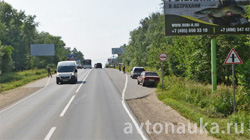 |
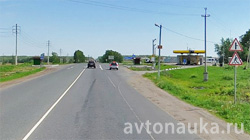 |
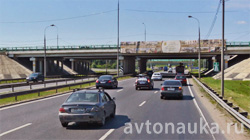 |
It should also be noted that the term "Main Road" is also used outside intersections - at the entry points to adjacent territories. Such sections are not considered intersections, however, adjacent territories are assigned the status of a secondary road, and the roads to which they adjoin are assigned the status of a main one.
In the absence of signs 2.1, 2.3.1-2.3.7 or 5.1, crossing paved roads, as well as crossing dirt roads, is considered equivalent.
"Daytime Running Lights"- external lighting devices designed to improve the visibility of a moving vehicle in front during daylight hours.
"Road"- a strip of land or the surface of an artificial structure, equipped or adapted and used for the movement of vehicles. The road includes one or more carriageways, as well as tram tracks, sidewalks, shoulders and dividing lanes, if any.
The main purpose of the road is to ensure the movement of vehicles and pedestrians. Roads include streets, avenues, highways, as well as dirt, forest, field roads, and even those that can be used for traffic only in winter.
"Road traffic"- a set of social relations that arise in the process of moving people and goods with or without vehicles within the roads.
"traffic accident"- an event that occurred during the movement of a vehicle on the road and with its participation, in which people were killed or injured, vehicles, structures, cargo were damaged, or other material damage was caused.
The types of accidents can be as follows: collision, rollover, collision with a standing vehicle, a pedestrian or a cyclist, an obstacle, horse-drawn vehicles or animals, etc. The actions of drivers involved in a road traffic accident (RTA) are given in clause SDA .
"Railroad crossing"- crossing the road with railway tracks at the same level.
Railway crossing - a section of the road intended for the passage of vehicles through the rail railway. This is one of the most dangerous places, as the stopping distance of the railway train is at least 800 meters. The rules for driving through railway crossings are formulated in the SDA.
"Route vehicle"- a public transport vehicle (bus, trolley bus, tram) designed to transport people on the roads and moving along an established route with designated stops.

Buses, trolleybuses and trams can be classified as route vehicles if they are currently transporting passengers along an established route, moving from one designated stop to another. In other cases, for example, when a route vehicle deviates from its route in order to shorten the path (this example does not apply to trolleybuses and trams), the listed vehicle does not have the status of a route vehicle.
"mechanical vehicle"- a vehicle driven by an engine. The term also applies to any tractors and self-propelled machines.
Power-driven vehicles are part of the general group of all vehicles. main feature mechanical vehicles - the presence of an engine. Non-mechanical vehicles are any vehicles that do not have their own motor installation that sets them in motion. These are all kinds of trailers, semi-trailers and trailers-dissolutions. They are operated in conjunction with a mechanical vehicle as part of road trains.
The rules included buses, trolleybuses, trams, cars and trucks, motorcycles, tractors, self-propelled vehicles as mechanical vehicles. Self-propelled vehicles are vehicles designed to perform a variety of jobs (snow plows, agricultural vehicles, rollers, loaders, asphalt pavers, etc.). Since November 5, 2014, mopeds have also been included in the category of mechanical vehicles.
"Moped"- a two- or three-wheeled motor vehicle, the maximum design speed of which does not exceed 50 km/h, which has an internal combustion engine with a displacement not exceeding 50 cubic meters. cm, or an electric motor with a rated maximum power in continuous load mode of more than 0.25 kW and less than 4 kW. Quadricycles with similar technical characteristics are equated to mopeds.
"Motorbike"- a two-wheeled motor vehicle with or without a side trailer, the engine capacity of which (in the case of an internal combustion engine) exceeds 50 cubic meters. cm or the maximum design speed (with any engine) exceeds 50 km/h. Tricycles, as well as quadricycles with a motorcycle seat or motorcycle-type handlebars, having an unladen mass not exceeding 400 kg (550 kg for vehicles intended for the transport of goods), excluding the mass of batteries (in the case of electric vehicles), and a maximum effective engine power not exceeding 15 kW.
The curb weight is regulated by the vehicle manufacturer. It means the mass of a fully equipped and refueled vehicle without passengers and cargo.
"Locality"- a built-up area, the entrances to which and the exits from which are marked with signs 5.23.1 - 5.26.
Signs 5.23.1 and 5.24.1 are made in the form of plates with a white background, on which the names of settlements are written. Signs 5.23.2 and 5.24.2 are a symbolic image of the settlement, made on a white background.
If you passed signs 5.23.1 or 5.23.2 (with a white background), then you must comply with all traffic rules regarding the traffic order in populated areas.
Signs 5.25 and 5.26 are made in the form of plates with a blue background, on which inscriptions with the name of the settlement are applied. These signs are used to inform that in the indicated settlement on this road (or on its section) the requirements regarding traffic in settlements do not apply, i.e. it is necessary to comply with the requirements of the traffic rules in force outside of populated areas.
If you turned off the section of the road on which sign 5.25 (with a blue background) was installed, but did not leave the settlement, then follow the traffic rules that establish the order of movement in settlements.
"Insufficient Visibility"— the visibility of the road is less than 300 m in conditions of fog, rain, snowfall and the like, as well as at dusk.
- advance of one or more vehicles associated with the exit to the lane (side of the carriageway) intended for oncoming traffic, and subsequent return to the previously occupied lane (side of the carriageway).
 |
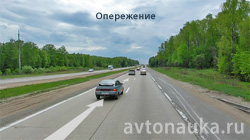 |
The main sign of overtaking as an advance of a moving vehicle (one or more) is the exit from the lane in which you were moving earlier to the lane (side of the road) in the opposite direction.
Therefore, rebuilding is a mandatory component of overtaking. However, you can rebuild without leaving the oncoming lane. Advancing within the carriageway of a passing direction is not considered overtaking.
"Roadside"- an element of the road adjacent directly to the carriageway at the same level with it, differing in the type of coverage or marked out using markings, used for movement, stopping and parking in accordance with the Rules.
The curb is intended for pedestrian traffic and stopping vehicles. If there is a curb suitable for stopping, traffic rules prohibit deliberately stopping traffic on the carriageway. The use of roadsides for the movement of vehicles is generally prohibited (p. SDA).
"Limited Visibility"— the driver's visibility of the road in the direction of travel, limited by the terrain, the geometric parameters of the road, vegetation, buildings, structures or other objects, including vehicles.
"Moving Danger"- a situation that has arisen in the process of traffic, in which the continuation of movement in the same direction and at the same speed creates a risk of a traffic accident.
It is important for the driver to be able to predict the development of traffic situations and prevent them from developing into an accident. If there is a danger to traffic that the driver is able to detect, it is necessary to take possible measures to reduce speed until the vehicle stops (p. SDA).
"Dangerous Goods"- substances, products made from them, wastes from production and other economic activities, which, due to their inherent properties, may pose a threat to human life and health during transportation, harm the environment, damage or destroy material values.
Vehicles carrying dangerous goods are subject to a number of special design requirements. On such vehicles, a flashing beacon of orange or yellow color, and in front and behind they apply (install) identification marks "Dangerous goods".
- the movement of the vehicle at a speed greater than the speed of the passing vehicle.
Leading does not imply exit to the adjacent lane and can be performed both on the left and on the right.
"Organized transportation of a group of children"- transportation in a bus that is not related to a route vehicle, a group of children of 8 or more people, carried out without their legal representatives, except for the case when the legal representative (s) is (are) the appointed (and) accompanying (and ) or a designated healthcare professional.
Organized transportation of a group of children means special transportation. From January 1, 2014, transportation of a group of children is carried out only on buses. In front and behind such vehicles, identification signs "Transportation of children" are installed.
"Organized transport column"- a group of three or more motor vehicles following one after another in the same lane with permanently on headlights, accompanied by a lead vehicle with special color schemes applied to the outer surfaces and flashing beacons of blue and red colors.
Traffic rules prohibit crossing organized columns and taking a place in them (p.). An organized transport column can be considered a group of mechanical vehicles, consisting of at least three units of the specified equipment, moving with a special escort at the head of the column.
"Organized Foot Column"- a group of people designated in accordance with the Rules, moving together along the road in one direction.
"Stop"- intentional stoppage of the movement of the vehicle for up to 5 minutes, and also for more, if it is necessary for boarding or disembarking passengers or loading or unloading the vehicle.
A stop is defined by the SDA as a deliberate cessation of movement. It means that it is made by the driver at his will, and not for the reasons specified in the definition of "Forced stop", and not to fulfill the requirements of the traffic controller, and also not to stop at a traffic light, not to provide an advantage to other road users , not due to congestion, etc. No Stopping sign and/or horizontal markings (yellow) placed at the edge of the carriageway or along the top of the curb prevent intentional stopping of traffic.
In places where parking is prohibited, stopping is allowed (i.e., deliberately stopping traffic for up to 5 minutes). You can also stay there for a longer time if it is necessary for boarding and disembarking passengers, or loading a vehicle.
"Safety Island"- an element of the road arrangement that separates traffic lanes (including lanes for cyclists), as well as traffic lanes and tram tracks, structurally separated by a curb stone above the carriageway or marked by technical means of traffic management and intended to stop pedestrians when crossing the carriageway . A safety island may include a part of the dividing strip through which a pedestrian crossing is laid.
"Parking (parking space)"- a specially designated and, if necessary, equipped and equipped place, which is, among other things, part of the highway and (or) adjacent to the carriageway and (or) sidewalk, roadside, overpass or bridge, or which is part of the under-overpass or under-bridge spaces, squares and other street objects - the road network, buildings, structures or structures and intended for organized parking of vehicles on a paid basis or without charging a fee by decision of the owner or other owner of the motor road, the owner of the land plot or the owner of the relevant part of the building, structure or structure.
The term "" was introduced on August 6, 2013.
"Passenger"- a person, other than the driver, who is in the vehicle (on it), as well as a person who enters the vehicle (gets on it) or leaves the vehicle (gets off it).
The obligations of passengers are given in the SDA.
"Crossroads"- a place of intersection, junction or branching of roads at the same level, limited by imaginary lines connecting, respectively, opposite, the beginnings of the curvature of the carriageways, which are the most distant from the center of the intersection. Exits from adjacent territories are not considered intersections.
- place of concentration conflict situations. Here the TS trajectories can intersect, merge and branch. Trajectories of vehicles and pedestrians also intersect at intersections.
Crossroads can take a variety of forms. At intersections, roads can intersect, merge or branch out, having both one and several carriageways. To meet the requirements of a number of road signs and markings, the driver must be able to determine the number of carriageways that form an intersection. To calculate the number, let's mentally extend the carriageways of the roads to the intersection.
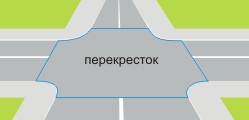 |
 |
 |
Road crossing at different levels, made in the form of bridges, overpasses, tunnels, as well as exits to the road from adjacent territories, are not considered intersections. It is necessary to correctly determine whether an intersection belongs to intersections: if an intersection is an intersection, then the requirements of traffic rules apply to it. In addition, a number of road signs in certain cases are valid until the nearest intersection. Therefore, in those places that are not considered intersections (departure from adjacent territories, intersections at different levels), these signs do not stop their action.
"Rebuilding"- exit from the occupied lane or occupied row while maintaining the original direction of movement.
The main requirement for rebuilding is the safety of maneuvering. Drivers resort to changing lanes when starting to move, when overtaking, bypassing, as well as occupying an appropriate position on the carriageway before turning, turning or stopping. More details about the rules for rebuilding are described in paragraph SDA, as well as in the article.
"A pedestrian"- a person who is outside the vehicle on the road or on a pedestrian or bicycle path and does not work on them. Persons moving in wheelchairs without an engine, driving a bicycle, moped, motorcycle, carrying a sledge, cart, baby or wheelchair, as well as using roller skates, scooters and other similar means for movement are equated to pedestrians.
Only those persons who are directly involved in the process of movement can be considered pedestrians. Consequently, regulators, as well as persons performing repair work etc., are not road users. Requirements for pedestrians are formulated in the SDA.
"Footpath"- a strip of land or a surface of an artificial structure, equipped or adapted for pedestrian traffic, marked with sign 4.5.1.
"Pedestrian zone"- the territory intended for the movement of pedestrians, the beginning and end of which are marked respectively by signs 5.33 and 5.34.
"Pedestrian and bicycle path (bike path)"- a road element (or a separate road) structurally separated from the carriageway, intended for separate or joint movement of cyclists with pedestrians and marked with signs 4.5.2 - 4.5.7.
« Crosswalk» - a section of the carriageway, tram tracks, marked with signs and (or) markings and allocated for pedestrian traffic across the road. In the absence of markings, the width of the pedestrian crossing is determined by the distance between signs 5.19.1 and 5.19.2.
Sign 5.19.1 is installed to the right of the road, sign 5.19.2 - to the left. On roads with a dividing strip, sign 5.19.2 is installed to the left of each of the carriageways on the dividing strip.
If there is no marking 1.14 at the crossing, sign 5.19.1 is installed on the near border of the crossing relative to approaching vehicles, and sign 5.19.2 - on the far one. Sign 5.19.2 may be placed on the reverse side of sign 5.19.1.
And at pedestrian crossings located on regulated intersections, signs may not be, pedestrians can only use the markings. It should be borne in mind that in the absence of all the attributes of a pedestrian crossing, pedestrians have the right to cross the carriageway at intersections along the line of sidewalks or roadsides (p. SDA).
"Lane"- any of the longitudinal lanes of the carriageway, marked or not marked with markings and having a width sufficient for the movement of cars in one row.
The traffic lane is the main element of the carriageway of any road. Its dimensions are regulated by regulatory documents. If there are no markings showing its dimensions, or if it is not visible, then drivers should consider the width of the carriageway sufficient for the movement of cars in one lane as a lane.
"Bicycle lane"- a lane of the carriageway intended for the movement of bicycles and mopeds, separated from the rest of the carriageway by horizontal markings and marked with the sign 5.14.2.
"Advantage (priority)"- the right to priority movement in the intended direction in relation to other participants in the movement.
Priority is a very important concept, directly related to the term “Give way (do not interfere)”.
"Let"— an immovable object on the lane (faulty or damaged vehicle, defect in the roadway, foreign objects, etc.) that does not allow you to continue driving along this lane. A traffic jam or a vehicle that has stopped in this lane in accordance with the requirements of the Rules is not an obstacle.
"Surrounding area"- the territory directly adjacent to the road and not intended for through traffic of vehicles (yards, residential areas, parking lots, gas stations, enterprises, etc.). Movement on the adjacent territory is carried out in accordance with these Rules.
The surrounding area is directly adjacent to the road. The exits from adjacent territories have been assigned the status of minor roads. Therefore, when leaving it, you should give way to vehicles and pedestrians on the road you are entering. (p. SDA).
"Trailer"- a vehicle not equipped with an engine and intended to be driven in combination with a power-driven vehicle. The term also applies to semi-trailers and drop trailers.
A trailer is a non-mechanical vehicle. He travels as part of a road train. The trailer rests on the road with all wheels and is attached to the tractor with the help of a drawbar. The semi-trailer rests on the wheels and on the tractor vehicle. If you look from the side, then the semi-trailer seems to be sitting astride a towing vehicle. The dissolution trailer is used to transport goods of increased length (most often pipes or timber).
"Roadway"- an element of the road intended for the movement of trackless vehicles.
A road consists of one or more carriageways. If there are several carriageways, they are separated from each other by dividing lanes.
"Dividing Line"- an element of the road, allocated constructively and (or) using marking 1.2.1, separating adjacent carriageways, as well as the carriageway and tram tracks and not intended for the movement and stopping of vehicles.
"Permitted maximum weight"- the mass of the equipped vehicle with cargo, driver and passengers, set by the manufacturer as the maximum allowable. For the permitted maximum mass of the composition of vehicles, that is, coupled and moving as a whole, the sum of the permitted maximum masses of the vehicles included in the composition is taken.
An equipped motor vehicle is a vehicle fully fueled with the maximum level of oil and coolant in the units, with a spare wheel, tools, first aid kit, fire extinguisher and a sign emergency stop. Vehicles are divided into categories depending on their purpose, design features and permitted maximum weight.
"Adjuster"- a person duly endowed with the authority to regulate traffic using the signals established by the Rules, and directly exercising the specified regulation. The traffic controller must be in uniform and (or) have a distinctive badge and equipment. Regulators include employees of the police and military automobile inspection, as well as employees of road maintenance services, on duty at railway crossings and ferry crossings in the performance of their duties.
If traffic is controlled by a traffic controller, then drivers should be guided by his signals.
"Parking"- deliberate cessation of the movement of the vehicle for a period of more than 5 minutes for reasons not related to the boarding or disembarkation of passengers or loading or unloading the vehicle.
The terms "Parking" and "Stopping" mean the intentional cessation of movement. A stop differs from a parking time by the time the vehicle is stationary. An intentional stoppage of traffic for more than 5 minutes is considered a stop, and not a parking lot, if it is associated with the continuous boarding or disembarkation of passengers, loading or unloading the vehicle.
"Night time"- the time interval from the end of evening twilight to the beginning of morning twilight.
During the specified period of time, external lighting devices cannot be dispensed with. This term is specified in p and in the SDA.
"Vehicle"- a device designed for the transport by road of people, goods or equipment installed on it.
Vehicles include both mechanical (engine-powered) and non-mechanical (non-engine) vehicles.
"Sidewalk"- an element of the road intended for the movement of pedestrians and adjacent to the carriageway or to the cycle path or separated from them by a lawn.
By definition, a sidewalk is for pedestrians. In the cases specified in paragraphs. and traffic rules, it is allowed to move, stop and even park the vehicle.
"Give way (do not interfere)"- a requirement meaning that a road user must not start, resume or continue driving, perform any maneuver if this may force other road users who have an advantage over him to change direction or speed.
"Give way" - this term is faced by every driver as soon as he wants to start moving from the edge of the road. Traffic rules require him to give way to moving vehicles before starting to move. What does it mean to give way? It means not to interfere. If you start on a multi-lane road, make sure that the lane you are about to use is clear and no moving vehicles are moving into it.
"Road user"- a person directly involved in the process of movement as a driver, pedestrian, passenger of a vehicle.
"School bus"- a specialized vehicle (bus) that meets the requirements for vehicles for transporting children, established by the legislation on technical regulation, and owned or otherwise legally owned by a preschool educational or general educational organization.
"Electric car"- a vehicle driven solely by an electric motor and charged using an external source of electricity.
1.3. Road users are obliged to know and comply with the requirements of the Rules, traffic lights, signs and markings that apply to them, as well as follow the orders of traffic controllers acting within the rights granted to them and regulating traffic with established signals.
1.4. Installed on the roads right-hand traffic Vehicle.
1.5. Road users must act in such a way that they do not endanger traffic or cause harm. It is forbidden to damage or pollute the road surface, remove, obstruct, damage, arbitrarily install road signs, traffic lights and other technical means of organizing traffic, leave objects on the road that interfere with traffic. The person who created the obstacle is obliged to take all possible measures to eliminate it, and if this is not possible, then by available means to ensure that road users are informed about the danger and inform the police.
1.6. Persons who violate the Rules are liable in accordance with applicable law.
The legislation of the Russian Federation provides for a driver, depending on the type traffic violations and its consequences administrative, criminal and civil liability.
1.2. The following basic concepts and terms are used in the Rules:
(Author's note: we will consider the main terms and definitions not in alphabetical order, but by combining them by meaning)
Roads, their types, elements and territories adjacent to them
"Road"- a strip of land or the surface of an artificial structure, equipped or adapted and used for the movement of vehicles. The road includes one and several carriageways, as well as tram tracks, sidewalks, shoulders and dividing lanes, if any.
Roads include streets, avenues, highways, dirt, forest and field roads, as well as those that can only be used for movement in winter (for example, ice crossings). The main purpose of the road is to provide traffic and pedestrians.
Roads in a built-up area usually consist of the elements shown in Fig. 1 and 2.
rice. 1. Road in the village
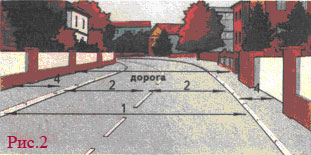
rice. 2. Road in the village

rice. 3. Road outside the settlement
On fig. 1-3, the following designations are adopted:
1 - roadway;
2 - traffic lane;
3 - dividing strip;
4 - sidewalk;
5 - curb.
"Sidewalk"- an element of the road intended for the movement of pedestrians and adjacent to the carriageway or separated from it by a lawn.
Outside the settlement, most often, roadsides are arranged instead of the sidewalk (Fig. 3). They are for pedestrians. Bicycles, mopeds, horse-drawn carts (sledges), riding and pack animals are allowed to move along the roadsides if it does not interfere with pedestrians. The movement of other vehicles on the roadsides is prohibited, except for the cases specified in paragraphs. 9.9 and 12.1 of the Rules.
"Roadway"- an element of the road intended for the movement of trackless vehicles (indicated by the number 1 in Fig. 1-3).
Tram tracks do not belong to the carriageway, but are its border (Fig. 4). However, in a number of cases, the departure of trackless transport onto tram tracks of the same direction, located on the same level with the carriageway, is not a violation (clauses 8.5 and 9.6 of the Rules).
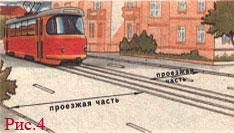
rice. 4. Dividing the road into carriageways
"Dividing Line"- a structurally separated road element that separates adjacent carriageways and is not intended for movement or stopping of trackless vehicles and pedestrians.
The dividing strip (Fig. 2) is almost always raised above the carriageway and is most often bordered by a curbstone. Quite often, lawns and sometimes tram tracks are placed on the dividing strip.
Tram tracks located on the dividing strip are not allowed to be used for the movement of trackless transport (Fig. 5).
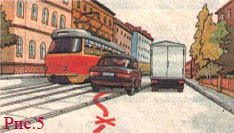
rice. 5. Tram tracks on the median strip
On fig. 6 shows a fragment of the Moscow Ring Road (MKAD). There is a median in the middle of the road. Consequently, there are two carriageways on the Moscow Ring Road.
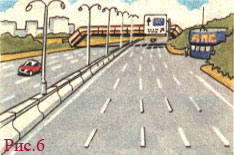
rice. 6. Moscow ring road highway(MKAD)
In the absence of a dividing strip, there is only one carriageway on the road. ATTENTION: any marking lines applied on the roadway are not a dividing strip. On fig. 7 in the center of the road is a solid double line markings are not a dividing line. Therefore, there is only one carriageway on such a road. However, in some cases, the dividing strip can be organized using the marking line 1.2.1, in which case the lines are at a sufficient distance from each other.

rice. 7. Double solid marking line - does not divide the road into carriageways!
"Lane"- any of the longitudinal lanes of the carriageway, marked or not marked with markings and having a width sufficient for the movement of cars in one row.
When determining the number of lanes, keep in mind that lanes are counted across the entire width of the road (from the left sidewalk or shoulder to the right sidewalk or shoulder). Therefore, there are ten traffic lanes on the Moscow Ring Road (Fig. 6). On the road shown in Fig. 7, - four. The traffic lane is intended for the movement of cars in one row (one after another). Motorcycles can move in one lane and in several lanes, since their width is not taken into account when determining the number of lanes on the road.
If the marking is not visible or absent and there are no signs 5.8.1, 5.8.2, 5.8.7, 5.8.8, then the number of lanes for traffic, in accordance with paragraph 9.1 of the Rules, is determined by the overall dimensions of the vehicles, taking into account the safe lateral interval between them . In this case, the side intended for oncoming traffic is considered to be the half of the carriageway located on the left (Fig. 8).

rice. 8. Determining the number of lanes
"Crosswalk"- section of the carriageway, marked with signs 5.16.1, 5.16.2 and (or) markings 1.14.1-1.14.3 and allocated for pedestrian traffic across the road. In the absence of markings, the width of the pedestrian crossing is determined by the distance between the signs 5.16.1 and 5.16.2.
On fig. 9 shows an unregulated pedestrian crossing.
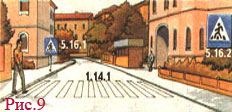
rice. 9. Unregulated pedestrian crossing
The concept of "Pedestrian crossing" also includes regulated crossings, in other words, those on which the order of movement of pedestrians and vehicles is controlled by traffic lights or traffic controllers.
The considered concept of "Pedestrian crossing" covers only ground crossings, that is, cases when pedestrians cross the carriageway at specified places.
However, the safest are underground and ground crossings, which are indicated by signs 5.17.1, 5.17.2 and 5.17.3, 5.17.4
If there is an underground or elevated crossing in the visibility zone, pedestrians are allowed to cross the carriageway only along them.
The road marked with sign 5.1 (Fig. 10).
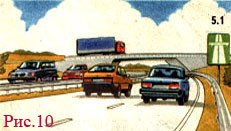
rice. 10. Motorway
Motorways- high-quality roads on which it is possible safe movement transport from high speeds. They must have at least two lanes for movement in one direction, oncoming flows are separated from each other by a dividing strip, intersections with other roads are made in the form of interchanges at different levels (bridges, flyovers, tunnels, etc.). It is no coincidence that sign 5.1 "Motorway" shows a road with a median strip and a bridge across it. Drivers can determine whether a road belongs to a motorway only by the presence of sign 5.1. Other signs listed above do not allow the driver to conclude that the road he is driving on is a motorway. The order of movement on motorways is set out in section 16 of the Rules.
"The main road"- a road marked with signs 2.1, 2.3.1, 2.3.2, 2.3.3 or 5.1 in relation to the crossed (adjacent) road (Fig. 10, 11), or a road with a hard surface (asphalt and cement concrete, stone materials, etc. similar) in relation to a dirt road (Fig. 12), or any road in relation to exits from adjacent territories (Fig. 18-20).

rice. 11. Options for marking the main road
If there are no signs specified in the definition of “Main Road” before the intersection, and the crossing (adjacent to each other) roads have a hard surface, then they are considered equivalent. In this case, the crossing of dirt roads is also considered equivalent.
The presence of a paved section on a secondary road immediately before the intersection does not make such a road equal in value to the intersected one.
The pavement on the secondary road just before the junction prevents dirt from entering the main road from the dirt road, acting as a kind of floor mat (Fig. 12).
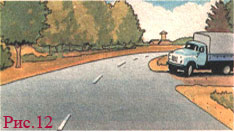
rice. 12. Truck on a secondary road
"Surrounding area"- the territory directly adjacent to the road and not dedicated to the through traffic of vehicles (yards, residential areas, parking lots, gas stations, enterprises, etc.).
Entrances to adjacent territories are not considered intersections. Consequently, in such places, road signs, the requirements of which extend to the nearest intersection, do not stop their operation.
- Burns, Robert - short biography
- The concept of common vocabulary and vocabulary of limited use
- Nancy Drew: The Captive Curse Walkthrough Nancy Drew Curse of Blackmoore Manor Walkthrough
- Deadpool - Troubleshooting
- Won't start How to Survive?
- What to do if bioshock infinite won't start
- Walkthrough Nancy Drew: Alibi in Ashes
- Spec Ops: The Line - game review, review Spec ops the line crashes on missions
- Room escape level 1 walkthrough
- Processing tomatoes with boric acid How much will 2 grams of boric acid
- Cucumber Grass (Borago)
- Bioinsecticide Lepidocid: purpose, properties and application procedure Lepidocide waiting period
- How to change the language to Russian in steam
- Dendrobium noble: room care
- Morphology of plants general concepts - document
- Planting, propagation and care of bamboo at home, photo Growing bamboo from seeds
- How to strengthen the cellular signal for the Internet in the country
- Sanskrit reveals the forgotten meaning of Russian words (2 photos)
- The oldest language Sanskrit programming language of the future Dead language Sanskrit
- Who has dominion over all the earth?









